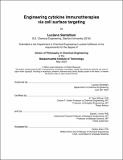| dc.description.abstract | Cancer immunotherapy targets immune cells to trigger a highly specific, long-lasting anti-tumor response. With the clinical success of immune checkpoint blockade and the development of promising next-generation agents, immunotherapy is steadily growing as a key pillar of the oncology clinic alongside surgery, radiation, and chemotherapy. Cytokines, endogenous regulators of immune responses, have long been promising immunotherapy candidates due to their innate ability to modulate lymphocyte behavior. However, translation of cytokines as systemically administered immunotherapies has been severely limited by on-target/off-tissue toxicity. One approach to overcome this challenge is to engineer cytokines for intratumoral retention following local administration to isolate their activity to on-target tissue. In this thesis, we explore an immune cell-based localization strategy by designing, evaluating, and optimizing antibody-cytokine fusions targeting the ubiquitous leukocyte receptor CD45.
First, we engineer and profile an αCD45-IL15 fusion that exhibits significantly diminished receptor-mediated internalization relative to its wild-type counterpart. This extended surface half-life augments downstream pSTAT5 induction and enables both cis and trans signaling between lymphocytes. We demonstrate this enhanced cell-surface biology is consistent when this approach is applied to another pro-inflammatory cytokine, IL-12. Preliminary experiments additionally suggest conserved internalization behavior between mouse and human CD45. Intratumoral αCD45-cytokine administration at specified doses leads to decoration of leukocytes in the tumor and tumor-draining lymph node (TDLN) while sparing systemic exposure. Biodistribution experiments suggest dose-dependent drainage of CD45-targeted proteins from the tumor through the TDLN and into systemic circulation, allowing for compartment specific targeting.
In the second part of the thesis, we develop and deeply characterize a two-dose sequential cytokine therapy termed αCD45-Cyt that safely elicits profound anti-tumor immunity. In this paradigm, a single dose of αCD45-IL12 followed by a single dose of αCD45-IL15 is able to eradicate both treated tumors and untreated distal lesions in multiple syngeneic mouse tumor models. Mechanistically, the improved intratumoral and nodal retention driven by CD45 targeting enabled reprogramming of tumor specific CD8+ T cells in the TDLN to exhibit an anti-viral transcriptional signature. Finally, we discuss preliminary data and plans for translating αCD45-Cyt therapy. Altogether, this thesis highlights the power of targeting host immune cells for use in immunotherapy and more broadly discusses the ability of multi-receptor targeting to elicit new signaling biology. | |
